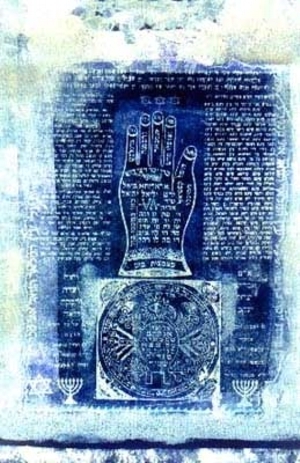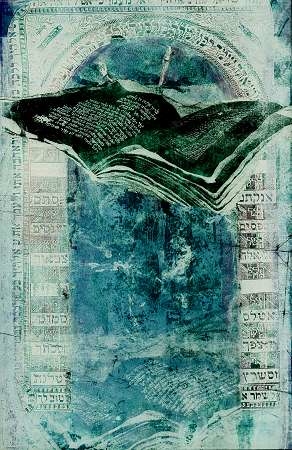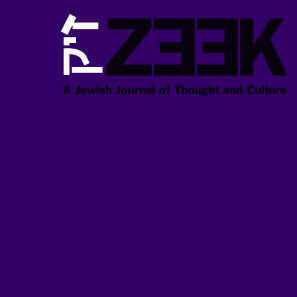 March 08
March 08
Is Kabbalah Mysticism? Continuing the Debate
by Shaul Magid and Boaz Huss
p. 2 of 3
 First, the question of if, how, and when the transition from myth to mysticism takes place occupies the final thoughts in Michael Fishbane’s Biblical Myth and Rabbinic Mythmaking. Although Fishbane never defines mysticism in this context, he writes as follows:
First, the question of if, how, and when the transition from myth to mysticism takes place occupies the final thoughts in Michael Fishbane’s Biblical Myth and Rabbinic Mythmaking. Although Fishbane never defines mysticism in this context, he writes as follows:
Where in this system does myth end and mysticism begin? Or: Where in this world-view can we say that we have moved from a mythical reality into a mystical one? There is no simple solution and I would suggest the following consideration. The move from myth to mysticism may be effected at the point where the component features of myth are not elements of an external narrative or divine drama, but rather spiritual components of a divine reality which the individual has internalized through the interiorization of the mythic dramas, the person assimilates the modalities of the divine reality and strives to actualize its truths in every thought and action…Myth may therefore comprise and condition a mystical mentality – not by being transcended so much as by being fully subjectivized and lived.11
Concluding his study of myth and mythmaking in biblical, rabbinic and kabbalistic Judaism, Fishbane suggests here that mythmaking, as a product of the exegetical imagination, can also transcend itself into the realm of the mystical. The reader and maker of the myth can, at times, step inside the mythic creation through “interiorization” thereby becoming a part, and not merely an observer or reader, of the mythic drama. While it is true that Fishbane uses the term “divine reality” to describe the myth interiorized, he is not making a theological claim, that is, a claim about God, but rather a functional claim about how the myth can transform its reader (and author). Thus Fishbane’s “modalities of the divine reality” constituted by the myth itself are, in fact, creations of the mythmaker that then become her template for living. As Fishbane suggests in another context, this process is achieved through the act of “reading.”12 This notion is proffered in a slightly different format by Melila Hellner-Eshed in her Hebrew study of the Zohar And the River Goes Out from Eden.13 Hellner-Eshed offers an aesthetic rendering of the Zohar as “art,”14 an object that can serve its reader as a vehicle for what we may, in our context, call a mystical experience. Hellner-Eshed calls our attention to various zoharic texts where a sage and his circle relate a mythic story and then, through what she calls a “leap” become part of the mythic story being told. The homiletical frame of the Zohar’s narrative is sometimes transformed into the experience of the circle.15 This transformation in the Zohar’s narrative Hellner-Eshed calls “mystical.”16 Is this a theological claim? In one sense it assumes a theological premise but it not making any claim about the nature of God. In fact, its focus is on the experience itself rather then the object of experience. In these examples, mysticism serves as a category linked to but distinct from myth, a term that describes the movement of myth from a dramatization of the real to the real itself through reading.
Alain Badious’ Saint Paul: The Foundation of Universalism is not at all about mysticism but about constituting “truth” out of what he calls the “event” (here the event of resurrection as experienced by Paul) as the source out of which all truth emerges.17 My interest in Badiou here is to use his discussion of “charisma” as a way to think about how the term mysticism can relate to moments or, in this case, events, that express “truth” without the unwanted baggage of theology. The context of Badiou’s comment is Paul’s rejection of works and law as salvific in Romans 4.4, “To one who works, his wages are not reckoned as a grace but as his due.” On this Badiou writes,
But for Paul, nothing is due. The salvation of the subject cannot take the form of a wage or reward. The subjectivity of faith is unwaged. It pertains to the granting of a gift, kharisma. Every subject is initiated on the basis of a charisma; every subject is charismatic. Since the subjectivating point is the declaration of the event, rather than the work that demands a wage or reward, the declaring subject exists according to the charisma power in him.18
At first blush, Badiou seems quite close to the rabbinic adage of “not serving one’s master for the sake of reward” but for its own sake.19 But there is more here. The rabbinic assertion is made precisely in a covenental theology  where reward is promised. But for Badiou, the charisma, or gift, is an act of grace whereby one’s “subjectivity is unwaged” that is, where the distinction between the giver, the gift, and its recipient ceases to exist – in fact it never existed. The radical subjectivity in question is the unfolding of charisma of the believing subject, not a belief in God or in resurrection as a historical phenomenon, but in the universalizing power that can be born from fidelity to what the event of resurrection represents. Only a truly believing subject – one’s whose fidelity is unassailable - can actualize the event by remaining faithful to it; only she can reach the place where “wage” or reward has no economy whatsoever. The truth thus lies in the collapse of difference as the “practice” of the universal. Badiou continues, “the subject constituted by charisma through the gratuitous practice of the universal address necessarily maintains there are no differences. Only what is charismatic, thus absolutely without cause, possesses this power of being in excess of the law, of collapsing differences.”20 Badiou's interests here are neither historical nor theological. His focus is one of fidelity to the (non-historical) event of resurrection - the centerpiece of Paul’s theology - and bringing about or produce its universal and universalizing power. My more limited interest is to consider whether we have here an example of a non-theological experiential claim (i.e., not about God but about the human and his relation to other humans) that may enter into the realm of the mystical.
where reward is promised. But for Badiou, the charisma, or gift, is an act of grace whereby one’s “subjectivity is unwaged” that is, where the distinction between the giver, the gift, and its recipient ceases to exist – in fact it never existed. The radical subjectivity in question is the unfolding of charisma of the believing subject, not a belief in God or in resurrection as a historical phenomenon, but in the universalizing power that can be born from fidelity to what the event of resurrection represents. Only a truly believing subject – one’s whose fidelity is unassailable - can actualize the event by remaining faithful to it; only she can reach the place where “wage” or reward has no economy whatsoever. The truth thus lies in the collapse of difference as the “practice” of the universal. Badiou continues, “the subject constituted by charisma through the gratuitous practice of the universal address necessarily maintains there are no differences. Only what is charismatic, thus absolutely without cause, possesses this power of being in excess of the law, of collapsing differences.”20 Badiou's interests here are neither historical nor theological. His focus is one of fidelity to the (non-historical) event of resurrection - the centerpiece of Paul’s theology - and bringing about or produce its universal and universalizing power. My more limited interest is to consider whether we have here an example of a non-theological experiential claim (i.e., not about God but about the human and his relation to other humans) that may enter into the realm of the mystical.
Coming from very different places Fishbane and Badiou may be making similar observations about what Fishbane calls the transition from myth to mysticism (using the terms interiorization and subjectivication) and Badiou calls the subjectivization of the event as an act of salvation, defined as the charisma, or gift, of every believing subject. As long as the myth remains external to the subject in Fishbane and the event is not a charisma, or gift, in Badiou, the subjectivication cannot fully unfold and, for Fishbane myth remains myth distinct from the subject (and thus not mystical) and, in Badiou, the event is not salvific (and thus not “true”) and Paul’s question “what is due” (i.e., works or the law) remains relevant.
Finally, I want to cite a excerpt from a homily by Kalomymous Kalman Shapira’s Aish Kodesh which I hope illustrates this point of subjectification as the condition of the mystical. Here my claim is that the mystical (implied but ever mentioned) makes a claim about human authority in relation to divine decree.
In the early spring of 1939 Shapira gave a sermon to his besieged congregants in the Warsaw Ghetto based on Rashi’s comment to Exodus 39:43 concerning the work of constructing the Tabernacle.21 And when Moses saw they performed all the tasks – as God had commanded, so they had done, Moses blessed them. Shapira invokes a Talmudic passage (b.T. Berakhot 5a).
When God told Moshe, ‘go tell Bezalel, make me a Tabernacle, an Ark, and vessels,’ Moses went and reversed the order. He told him to ‘Make an Ark, vessels, and a Tabernacle.’ Bezalel responded, ‘Moshe my teacher, it is the way of the world that a person first build a house and only afterward bring vessels into it but you told me to build the Ark and the vessels and only afterward the Tabernacle. If I do it that way, where will I bring the vessels? Perhaps [Bezalel says] God told you, Make the Tabernacle, Ark, and then the vessels?’ Moses replied, your name means ‘in the shadow of God’ (be-zel ‘El) and thus you must know [the correct procedure].’
In trying to comprehend Bezalel’s daring correction to Moses’ prophecy Shapira deploys a talmudic passage from b.T Yebamot 49, “Menashe asked Isaiah the prophet, ‘Moses your teacher said, no one can see [the face of God] and live. And you say, And I saw God. The gemara responds that Moses saw through a clear glass (aspaklaria he-meria) and Isaiah through a dark glass. Shapira continues that from Moses’ too-clear prophetic prospective, one cannot see God, but since Isaiah’s perspective was already tainted (or, tinted), he could, in fact, see God. Shapira then continues, this distinction applies not only to prophecy but also to devotion, even devotion that includes all manner of kabbalistic preparation. In such a case the kabbalistic preparations are only efficacious if the physical mitzvah is enacted. Yet, in the divine world where Moses dwelled, there are no distinctions; all worlds become nothing until there is no possibility of any particularity as there is in the lower world, the world of concealment. Hence, the physical enactment of constructing the Tabernacle was accomplished by Bezalel because Moses could not (physically) perform (or even fully understand) the act. Distance from the divine allowed Bezalel see more clearly than Moses.
In other words, this text suggests that Moses was incapable of correctly getting the order of the construction because he occupied a space where those distinctions did not matter – in fact where they did not exist. That is, he experienced the world from a mystical dimension that he could not transcend. Put in another way, there was no distinction between Moses and the commandment he was commanded to relate. This is one way to read “a glass that shines” (aspaklaria he-meira) a state where the glass ceases to function as intermediary. And without such an intermediary, prophecy is too clear; it cannot address the implementation of the details of any commanded act. The mystical source of commandment that is not mediated by something outside itself can never be a part of the world and thus can never function authoritatively. While the authority of the message (the commandment) remains and Moses as its source is maintained, the authority of the mystic here is undermined, not because he is distant from God but rather because he is too close to God. In this light Shapira cleverly turns the talmudic description of Bezalel as “the shadow of God” – a complimentary term in the Talmud - on its head. Bezalel means “the shadow of God” that is, one who sees God as one sees a shadow, in a concealed manner – he is far enough away from God to be able to know the details of divine will. Because Bezalel is not a mystic, he can (and must!) correct Moses in the practical implementation of the commandment. Moses, as a mystic, is too close for there to be any details, or difference, at all. While surely founded on definite theological principles, Shapira’s observation that “Moses can only command” but not enact tells us more about religious authority than it does about theology.
While it is true that in Shapira Moses’ experience is, I assume, an experience of God, I do not think that is the point or intent of the homily. Rather, the point is that Moses’ experience of God, while often viewed in laudatory terms, is simultaneously the foundation of, and also limitations to, religious authority. The mystic and his mystical experience is authoritative only the extent to which he can transcend his mystical experience. If he cannot (or if he does not have one who can correct him) he cannot be trusted to fully or adequately convey his message to those who choose to listen.
So, as in Fishbane and Badiou, mysticism here means the description of a human experience of radical “subjectification” or “interiorization” (contextually determined) whereby the individual comes to experience the world, and herself, in a new way. This definition is not theological; it does not necessarily require an encounter with God. With Fishbane it is an encounter with a humanly created myth, with Badiou an (imagined) event, and with Shapira (using Moses’ encounter with God as a template) the realization that a human experience that may reach beyond the details of worldly existence cannot fully function as authoritative.
While I sympathize with Boaz Huss’ attempt to unmoor the academic study of Kabbala from the doctrines and suppositions of kabbalistic praxis and belief, and I agree that when the term “mysticism” is deployed uncritically or to push a particular theological agenda, it should be avoided, I suggest that the term still can serve a positive function as a means of describing certain dimensions of human, and religious, experience.22 In the three examples provided above – each with widely different conclusions – I suggest the deployment of a category such as “mysticism” may be useful to define and examine a human phenomenon that is part of a religious activity that stands outside the normative structures we usually use to define human perception or behavior. Whether it is the spiritualizing dimension of reading, the truth of the universal embedded in fidelity to an event, or questioning the problematic transition from unmediated prophecy to religious authority, the term and category we call “mysticism,” if deployed critically, can play a role for the scholar. Thus, even without an air-tight definition (following Scholem) and without using it to make or bolster theological claims that would make it unworthy of academic discourse (following Huss), mysticism can still serve the scholar of religion and Judaism.
I am in full agreement with Huss that the scholar of so-called “mystical texts” should not confirm or deny any of the claims made by the texts. Rather he or she is the business of closely examining how these claims are made, their taxonomy, texture, and argumentation, and then attempt to describe and illuminate these claims through critical, historical, and phenomenological analysis. As Moshe Idel has argued in what he calls “methodological eclecticism” (and as many scholars practice) the scholar of Kabbala should have the full array of methods, terminology, and nomenclature at their disposal to best achieve these goals.23 Nothing should, by definition, be excluded from the scholars’ toolbox as long as she is critical and careful about how such methods are utilized. The fact that categories may be rooted in Christianity, Islam, Hinduism or Hellenism should, perhaps, give the scholar of Kabbala pause but should not limit her work of translation, as all “western” scholarship of “non-western” phenomena is in the end an act of translation. While I am in agreement with Huss about the origins, and even the dangers, of the term “mysticism,” I argue that the term can be productive to illuminate certain human experiences that are expressed throughout the history of human creativity, including those of some kabbalists.
To return once more to Fishbane and Badiou, the structures that inform our religious lives, be they myths, historical, or phenomenal events, exist outside the purview of the mystical experience as pure subjectivity. But what do we call such human experience that arises from within these structures yet crosses a line to territory yet undescribed? In this sense, I suggest the kabbalist can become a mystic but in that state he or she is not a kabbalist. This is because the kabbalist is more (by being less) than a mystic. He (or she) must transcend the experience – move beyond the ecstatic by leaving it behind - in order to provide mediation necessary for communication. Moses, in Shapira’s rendering, was a mystic but no kabbalist, and kabbalists, I would suggest, cannot purely be mystics (as the rabbi of a community in crisis perhaps this is part of what Shapira wanted to convey in his homily). Achieving what Fishbane calls “the interiorization of the mystic drama,” what Badiou calls fidelity to the “event” may require a leap from the real to the realm of the mystical (whether it is a place within or outside human subjectivity is not the interest of the scholar) but the description of such a reading, or the implementation of the event’s universal message, requires one to move beyond, by moving outside, the experience itself. I suggest that the term “mysticism” works here as a way to describe one dimension of this process in order to highlight the difference between these two moves – from the “real” and then back to the “real” newly constituted by stepping outside it. In principle, this does not require any fidelity to a particular theological truth or claim about universal “mystical” experience. It is, rather, one way to describe the complex nature of human subjectivity and how that subjectivity constructs the world.
Footnotes
11 Michael Fishbane, Biblical Myth and Rabbinic Mythmaking (Oxford, UK, 2003), pp. 313-314.
12 See Fishbane, “The Book Zohar and Exegetical Spirituality,” p. 110. “The mystical meaning builds on the literal dimension of this reading, even as it simultaneously interprets the images symbolically. Through such a characteristic interfusion of hermeneutical registers (the literal and the symbolic), a ,ytic dimension emerges from Scripture. In this case, the scholar assimilates the properties of the Torah he studies and becomes a tree - a cosmic tree, in fact, that links the earthly and divine realms into one divine whole.”
13 Melila Hellner-Eshed, And the River Goes out From Eden [Hebrew] (Jerusalem, 2006). This dimension of Hellner-Eshed’s thesis is discussed by the forthcoming review essay by Nathaniel Berman, “Aestheticism, Rationalism, and Esotericism: Medieval Scholarship and Contemporary Polemics,” in Jewish Quarterly Review. I want to thank Nathaniel Berman for making his essay available to me before its publication.
14 Hellner-Eshed, And the River, p. 16.
15 This is also similar to the children’s book The Little Prince where the boy draws a picture that he steps into and then becomes his world.
16 See, for example, ibid. p. 289.
17 The “event” as a philosophical truth category is the subject of his major work Being and Event (New York: Continuum International, 2007). In his Saint Paul: The Foundation of Universalism, Ray Braissier trans. (Stanford: Stanford University Press, 2003). Badiou examines Paul’s notion of resurrection as an “event” that embodies truth. However, this “event” has no theological import and the event itself is not necessarily, or not at all, the basis of Christianity. It is, rather, an exemplar of a moment that embodies universalism through difference. The event is something that we cannot perceive until after the fact. Truth is thus constituted in the wake of the event, the event itself is not true but produces the truth. I want to thank Kenneth Reinhard for his help in formulating Badiou’s position.
18 Badiou, Saint Paul, p. 77.
19 Mishna Avot 1:3.
20 Badiou, Saint Paul, p. 78.
21 Shapira, ‘Aish Kodesh, (Jerusalem, 1960), pp. 25-27.
22 In regard to Huss’ comment on the assumption that “various cultural formations, including the Kabbalah, are a Jewish expression of universal mystical phenomenon” (“Jewish Mysticism in the University” p. 1), I remain agnostic. That is I do not know, nor am I particularly interested, in whether Kabbala is an expression of such a phenomenon or whether such a phenomenon is, in fact, universal. But I would claim that human experience, construed loosely and widely, is universal to human beings and that, as human beings, Kabbalists may have experiences that one could deem mystical that are surely not identical to those in other civilizations but can still be examined through a lens that is deployed elsewhere to describe different experiences as long as one remains aware of the pitfalls of simplistic comparison.
23 Moshe Idel, Ascensions on High in Jewish Mysticism: Pillars, Lines, Ladders (Budapest, NY: CUP Press, 2005), pp. 1-18.











